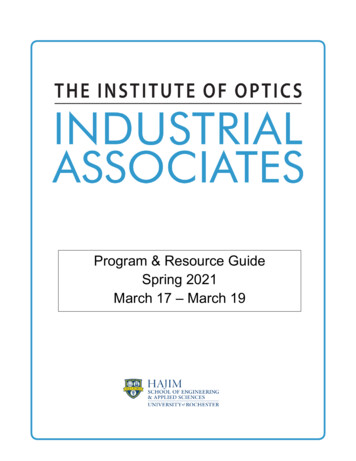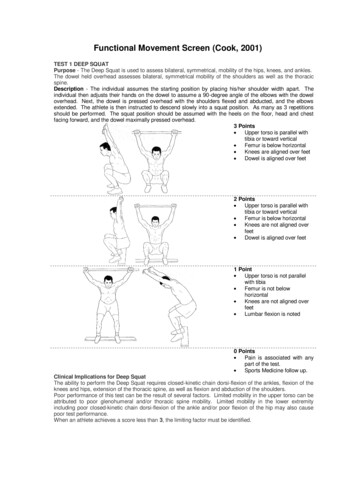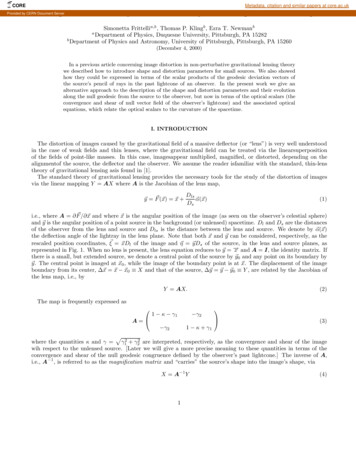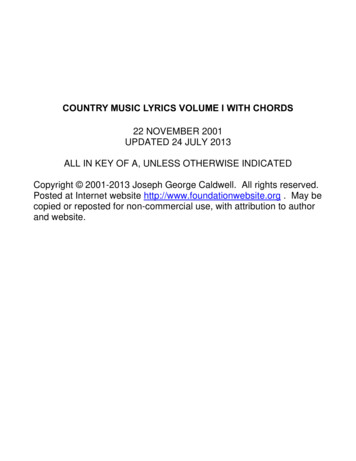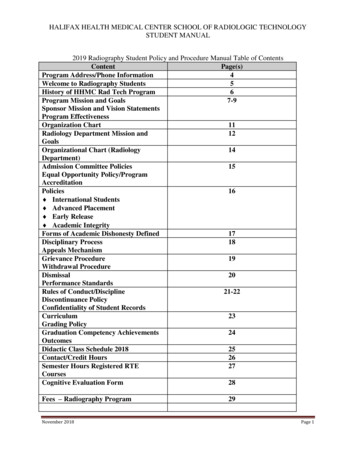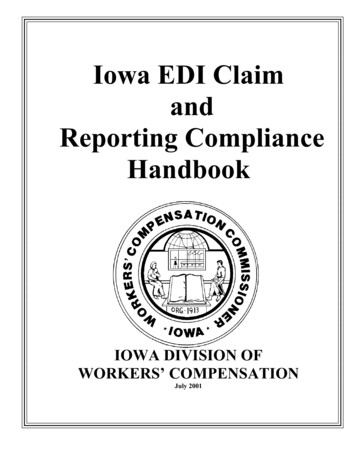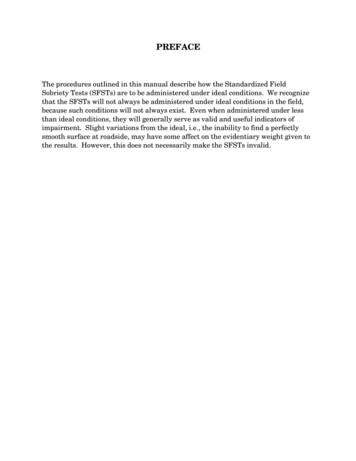
Transcription
PREFACEThe procedures outlined in this manual describe how the Standardized FieldSobriety Tests (SFSTs) are to be administered under ideal conditions. We recognizethat the SFSTs will not always be administered under ideal conditions in the field,because such conditions will not always exist. Even when administered under lessthan ideal conditions, they will generally serve as valid and useful indicators ofimpairment. Slight variations from the ideal, i.e., the inability to find a perfectlysmooth surface at roadside, may have some affect on the evidentiary weight given tothe results. However, this does not necessarily make the SFSTs invalid.
DWI DETECTIONANDSTANDARDIZED FIELD SOBRIETY TESTINGI.Introduction and OverviewII.Detection and General DeterrenceIII.The Legal EnvironmentIV.Overview of Detection, Note-Taking and TestimonyV.Phase One: Vehicle in MotionVI.Phase Two: Personal ContactVII.Phase Three: Pre-arrest ScreeningVIII.Concepts and Principles of the Standardized Field Sobriety TestsIX.Test Battery DemonstrationsX."Dry Run" Practice SessionXI."Testing Subjects" Practice: First SessionXII.Processing the Arrested Suspect and Preparation for TrialXIII.Report Writing Exercise and Moot CourtXIV."Testing Subjects" Practice: Second SessionXV.Review and Proficiency ExaminationsXVI.Written Examination and Program Conclusion
SESSION IINTRODUCTION AND OVERVIEWHS 178 R1/02
SESSION IINTRODUCTION AND OVERVIEWUpon successfully completing this session, the students will be able to:oState the goals and objectives of the course.oDescribe the course schedule and activities.oDemonstrate their pre-training knowledge of course topics.CONTENT SEGMENTSLEARNING ACTIVITIESA.Welcoming Remarks and Objectiveso Instructor-Led PresentationsB.Administrative DetailsC.Pre-TestHS 178 R1/02o Written Examination
DWI DETECTION AND STANDARDIZED FIELD SOBRIETY TESTINGTRAINING GOALS AND OBJECTIVES1. Ultimate GoalTo increase deterrence of DWI violations, and thereby reduce the number ofcrashes, deaths and injuries caused by impaired drivers.2. Enforcement-Related Goalsa. Understand enforcement's role in general DWI deterrence.b. Understand detection phases, clues and techniques.c.Understand requirements for organizing and presenting testimonial anddocumentary evidence in DWI cases.3. Job Performance ObjectivesAs a result of this training, students will become significantly better able to:a. Recognize and interpret evidence of DWI violations.b. Administer and interpret Standardized Field Sobriety Tests.c.Describe DWI evidence clearly and convincingly in written reports andverbal testimony.4. Enabling ObjectivesIn pursuit of the job performance objectives, students will come to:a. Understand the tasks and decisions of DWI detection.b. Recognize the magnitude and scope of DWI-related crashes, deaths, injuries,property loss and other social aspects of the DWI problem.c.Understand the deterrence effects of DWI enforcement.HS 178 R1/02I-1
d. Understand the DWI enforcement legal environment.e.Know and recognize typical vehicle maneuvers and human indicatorssymptomatic of DWI that are associated with initial observation of vehiclesin operation.f.Know and recognize typical reinforcing maneuvers and indicators that cometo light during the stopping sequence.g. Know and recognize typical sensory and other clues of alcohol and/or otherdrug impairment that may be seen during face-to-face contact with DWIsuspects.h. Know and recognize typical behavioral clues of alcohol and/or other drugimpairment that may be seen during the suspect's exit from the vehicle.i.Understand the role and relevance of psychophysical testing in pre-arrestscreening of DWI suspects.j.Understand the role and relevance of preliminary breath testing inpre-arrest screening of DWI suspects.k. Know and carry out appropriate administrative procedures for validateddivided attention psychophysical tests.l.Know and carry out appropriate administrative procedures for theHorizontal Gaze Nystagmus test.m. Know and recognize typical clues of alcohol and/or other drug impairmentthat may be seen during administration of the Standardized Field SobrietyTests.n. Understand the factors that may affect the accuracy of preliminary breathtesting devices.o.Understand the elements of DWI prosecution and their relevance to DWIarrest reporting.p. Choose appropriate descriptive terms to convey relevant observations of DWIevidence.HS 178 R1/02I-2
q. Write clear, descriptive narrative DWI arrest reports.5. Additional Training Goals and Objectivesa. If the four-hour (Introduction to Drugs That Impair) or eight-hour (DrugsThat Impair Driving) modules are presented as part of the SFST trainingprogram, the goals and objectives for those modules are listed in theappropriate manuals.HS 178 R1/02I-3
ATTACHMENTGLOSSARY OF TERMSALVEOLAR BREATH - Breath from the deepest part of the lung.BLOOD ALCOHOL CONCENTRATION (BAC) - The percentage of alcohol in a person'sblood.BREATH ALCOHOL CONCENTRATION (BrAC) - The percentage of alcohol in aperson’s breath, taken from deep in the lungs.CLUE - Something that leads to the solution of a problem.CUE - A reminder or prompting as a signal to do something. A suggestion or a hint.DIVIDED ATTENTION TEST - A test which requires the subject to concentrate on bothmental and physical tasks at the same time.DWI/DUI - The acronym "DWI" means driving while impaired and is synonymouswith the acronym "DUI", driving under the influence or other acronyms used todenote impaired driving. These terms refer to any and all offenses involving theoperation of vehicles by persons under the influence of alcohol and/or other drugs.DWI DETECTION PROCESS - The entire process of identifying and gathering evidenceto determine whether or not a suspect should be arrested for a DWI violation. The DWIdetection process has three phases:Phase One - Vehicle In MotionPhase Two - Personal ContactPhase Three - Pre-arrest ScreeningEVIDENCE - Any means by which some alleged fact that has been submitted toinvestigation may either be established or disproved. Evidence of a DWI violation maybe of various types:a.b.c.d.e.Physical (or real) evidence: something tangible, visible, or audible.Well established facts (judicial notice).Demonstrative evidence: demonstrations performed in the courtroom.Written matter or documentation.Testimony.FIELD SOBRIETY TEST - Any one of several roadside tests that can be used todetermine whether a suspect is impaired.HORIZONTAL GAZE NYSTAGMUS (HGN) - An involuntary jerking of the eyes as theygaze toward the side.HS 178 R1/021
ILLEGAL PER SE - Unlawful in and of itself. Used to describe a law which makes itillegal to drive while having a statutorily prohibited Blood Alcohol Concentration.NYSTAGMUS - An involuntary jerking of the eyes.ONE-LEG STAND (OLS) - A divided attention field sobriety test.PERSONAL CONTACT - The second phase in the DWI detection process. In this phasethe officer observes and interviews the driver face to face; determines whether to askthe driver to step from the vehicle; and observes the driver's exit and walk from thevehicle.PRE-ARREST SCREENING - The third phase in the DWI detection process. In thisphase the officer administers field sobriety tests to determine whether there is probablecause to arrest the driver for DWI, and administers or arranges for a preliminary breathtest.PRELIMINARY BREATH TEST (PBT) - A pre-arrest breath test administered duringinvestigation of a possible DWI violator to obtain an indication of the person's bloodalcohol concentration.PSYCHOPHYSICAL - "Mind/Body." Used to describe field sobriety tests that measure aperson's ability to perform both mental and physical tasks.STANDARDIZED FIELD SOBRIETY TEST BATTERY - A battery of tests, HorizontalGaze Nystagmus, Walk-and-Turn, and One-Leg Stand, administered and evaluated in astandardized manner to obtain validated indicators of impairment based on NHTSAresearch.TIDAL BREATH - Breath from the upper part of the lungs and mouth.VEHICLE IN MOTION - The first phase in the DWI detection process. In this phasethe officer observes the vehicle in operation, determines whether to stop the vehicle,and observes the stopping sequence.VERTICAL GAZE NYSTAGMUS - The involuntary jerking of the eyes occurring as theeyes gaze upward.WALK-AND-TURN (WAT) - A divided attention field sobriety test.HS 178 R1/022
SESSION IIDETECTION AND GENERAL DETERRENCEHS 178 R1/02
SESSION IIDETECTION AND GENERAL DETERRENCEUpon successfully completing this session, the student will be able to:oDescribe the frequency of DWI violations and crashes.oDefine General Deterrence.oDescribe the Relationship between Detection and General Deterrence.oDescribe a brief overview of alcohol;oIdentify common types of alcohols;oDescribe the physiologic processes of absorption, distribution and eliminationof alcohol in the human body;CONTENT SEGMENTSLEARNING ACTIVITIESA.The DWI Problemo Instructor-Led PresentationsB.The Concept of General Deterrenceo Reading AssignmentsC.Relating Detection to Deterrence PotentialD.Evidence of Effective Detection andEffective DeterrenceE.Physiology of AlcoholHS 178 R1/02
DWI DETERRENCE: AN OVERVIEWEach year, tens of thousands of people die in traffic crashes. Throughout the nation,alcohol is the major contributor to traffic fatalities. Approximately 38.4% of all fatalcrashes are alcohol-related. (1998 NHTSA FARS data)Impaired drivers are more likely than other drivers to take excessive risks such asspeeding or turning abruptly. Impaired drivers also are more likely than otherdrivers to have slowed reaction times. They may not be able to react quickly enoughto slow down before crashing and are less likely to wear seatbelts. On the average,two percent of drivers on the road at any given time are DWI. DWI violations andcrashes are not simply the work of a relatively few "problem drinkers" or "problemdrug users." Many people commit DWI, at least occasionally.oIn a 1991 Gallup Survey of 9,028 drivers nationwide, 14% of the respondentsreported they drove while close to or under the influence of alcohol within thelast three months.It is conservatively estimated that the typical DWI violator commits that offenseabout 80 times per year. In other words, the average DWI violator drives whileunder the influence once every four or five nights.GENERAL DETERRENCEOne approach to reducing the number of drinking drivers is general deterrence ofDWI. General deterrence of DWI is based in the driving public's fear of beingarrested. If enough violators come to believe that there is a good chance that theywill get caught, at least some of them will stop committing DWI at least some of thetime. However, unless there is a real risk of arrest, there will not be much fear ofarrest.Law enforcement officers must arrest enough violators enough of the time toconvince the general public that they will get caught, sooner or later, if they continueto drive while impaired.How many DWI violators must be arrested in order to convince the public that thereis a real risk of arrest for DWI? Several programs have demonstrated thatsignificant deterrence can be achieved by arresting one DWI violator for every 400DWI violations committed. Currently, however, for every DWI violator arrested,there are between 500 and 2,000 DWI violations committed. (See Exhibit 2-1) Whenthe chances of being arrested are one in two thousand, the average DWI violatorreally has little to fear.HS 178 R1/02II-1
EXHIBIT 2-1Chances of a DWI violator beingarrested are as low as 1 in 2000.Why is the DWI arrest to violations ratio (1:2000) so low? There are threenoteworthy reasons.oDWI violators vastly outnumber police officers. It is not possible to arrest everydrinking driver each time they commit DWI.oSome officers are not highly skilled at DWI detection. They fail to recognize andarrest many DWI violators.oSome officers are not motivated to detect and arrest DWI violators.SIGNIFICANT FINDINGSIn a 1975 study conducted in Fort Lauderdale, Florida, only 22 percent of trafficviolators who were stopped with BACs between 0.10 and 0.20 were arrested for DWI.The remainder were cited for other violations, even though they were legallyimpaired. In this study breath tests were administered to the violators byresearchers after the police officers had completed their investigations. The officersfailed to detect 78 percent of the DWI violators they investigated.The implication of this study, and of other similar studies, is that for every DWIviolator actually arrested for DWI, three others are contacted by police officers, butare not arrested for DWI. (See Exhibit 2-2.) It is clear that significant improvementin the arrest rate could be achieved if officers were more skilled at DWI detection.HS 178 R1/02II-2
EXHIBIT 2-2For every DWI violator arrested, 3 others arecontacted face to face by police, but are notarrested.Several enforcement programs have succeeded in achieving significant DWIdeterrence. Consider, for example, the three year intensive weekend DWIenforcement program in Stockton, California. Under that program:oooarrests increased 500 percent;weekend nighttime crashes decreased 34 percent;the proportion of nighttime weekend drivers legally under the influencedropped from nine percent to six percent.Improved DWI detection can be achieved in virtually every jurisdiction in thecountry. The keys to success are police officers who are:oooskilled at DWI detection;willing to arrest every DWI violator who is detected;supported by their agencies in all aspects of this program, from policythrough practical application.THE PROBLEM OF DWIHOW WIDESPREAD IS DWI?While not all of those who drive after drinking have a BAC of 0.08/0.10 or more, thepresumptive or illegal per se limit for DWI in many states, some drivers do haveBACs in excess of these limits.HS 178 R1/02II-3
A frequently quoted, and often misinterpreted, statistic places the average inci-denceof DWI at one driver in fifty. Averaged across all hours of the day and all days of theweek, two percent of the drivers on the road are DWI.1 That 1 in 50 figure is offeredas evidence that a relatively small segment of America's drivers -- the so-called"problem" group -- account for the majority of traffic deaths. There's nothing wrongwith that figure as a statistical average, but police officers know that at certain timesand places many more than two percent of drivers are impaired. National HighwayTraffic Safety Administration research suggests that during the late night, weekendhours, as many as ten percent of drivers on the roads may be DWI.2 On certainholiday weekends, and other critical times, the figure may go even higher.HOW MANY? HOW OFTEN?The issue of how many DWIs are on the road at any given time is an importantfactor in measuring the magnitude of the problem. However, from an overall trafficsafety perspective, the more important issue may be the number of drivers who evercommit DWI. Just how widespread is this violation? In enforcement terms, howmany people do we need to deter?Clearly, it is more than one in fifty. Although it may be true that, on the average,two percent of drivers are DWI at any given time, it certainly is not the same twopercent every time. It is even more than one in ten. Not everyone who commits DWIis out on the road impaired every Friday and Saturday night. Some of them, at least,must skip an occasional weekend. Thus, the ten percent who show up, weekend afterweekend, in the Friday and Saturday statistics must come from a larger pool ofviolators, each of whom "contributes" to the statistics on some nights, but notnecessarily on all nights.An analysis of BAC roadside survey data suggests that the average DWI violatorcommits the violation approximately 80 times each year.3 Undoubtedly, there aresome who drive impaired virtually everyday; others commit the violation less often.It is likely that at least one quarter of all American motorists drive while impaired atleast once in their lives. That figure falls approximately midway between the 55percent of drivers who at least occasionally drive after drinking and the ten percentof weekend, nighttime drivers who have BACs above the so-called legal limit.1Borkenstein, R.F., et al, Role of Drinking Driver in Traffic Accidents.Bloomington IN: Department of Police Administration, Indiana University,March 1964.2Alcohol Highway Safety Workshop, Participant's Workbook Problem Status.NHTSA, 1980.HS 178 R1/02II-4
Our estimated one in four drivers includes everyone who drives impaired everyday,as well as everyone who commits the violation just once and never offends again; andit includes everyone in between. In short, it includes everyone who ever runs therisk of being involved in a crash while impaired.SOCIETY'S PROBLEM AND THE SOLUTIONIt really doesn't matter whether this one in four estimate is reasonably accurate (infact, it is probably low). The fact is that far more than two percent of Americandrivers actively contribute to the DWI problem. DWI is a crime committed by asubstantial segment of Americans. It has been and remains a popular crime; onethat many people from all walks and stations of life commit. DWI is a crime that canbe fought successfully only through a societal approach of comprehensivecommunity-based programs.THE SOLUTIONSTHE ULTIMATE GOAL: CHANGING BEHAVIORWhat must comprehensive community based DWI programs seek to accomplish?Ultimately, nothing less than fundamental behavioral change, on a widespreadbasis. The goal is to encourage more Americans to:oavoid committing DWI, either by avoiding or controlling drinking prior todriving or by selecting alternative transportation.ointervene actively to prevent others from committing DWI (for example,putting into practice the theme "friends don't let friends drive drunk");oavoid riding with drivers who are impaired.The final test of the value of DWI countermeasures on the national, state and locallevels is whether they succeed in getting significantly more people to modify theirbehavior. The programs also pursue other more immediate objectives that supportor reinforce the ultimate goal. However, the ultimate goal is to change driving whileimpaired to an unacceptable form of behavior at all levels.3DWI Law Enforcement Training: Instructor's Manual. NHTSA. August 1974.P.139.HS 178 R1/02II-5
PURSUING THE GOAL: TWO APPROACHESHow can we bring about these changes in behavior? How can we induce more peopleto avoid DWI violations, prevent others from drinking and driving, and avoidbecoming passive "statistics" by refusing to ride with drinking drivers? Basically,there are two general approaches that must be taken to achieve this goal. One:prevention -- gives promise of the ultimate, lasting solution to the DWI problem; butit will require a substantial amount of time to mature fully. The other -- deterrence -only offers a partial or limited solution, but it is available right now.PREVENTION: THE ULTIMATE SOLUTIONDWI countermeasures that strive for the ultimate achievement of drinking anddriving behavioral changes have been grouped under the label "Prevention." Thereare many kinds of DWI preventive activities. Some are carried out by and in ourschools, some through the mass media, some through concerned civic groups, and soforth. The various preventive efforts focus on different specific behaviors andaddress different target groups. However, they seek to change drinking and drivingbehavior by promoting more positive attitudes and by fostering a set of values thatreflects individual responsibilities toward drinking and driving.Preventive countermeasures seek society's acceptance of the fact that DWI is wrong.Some people believe that drinking and driving is strictly an individual's personalbusiness; that it is up to each person to decide whether or not to accept the risk ofdriving after drinking. Preventive activities try to dispel that outmoded andirresponsible belief. Instea
The procedures outlined in this manual describe how the Standardized Field Sobriety Tests (SFSTs) are to be administered under ideal conditions. . modules are presented as part of the SFST training program, the goals and objectives for those modules are listed in the appropr
